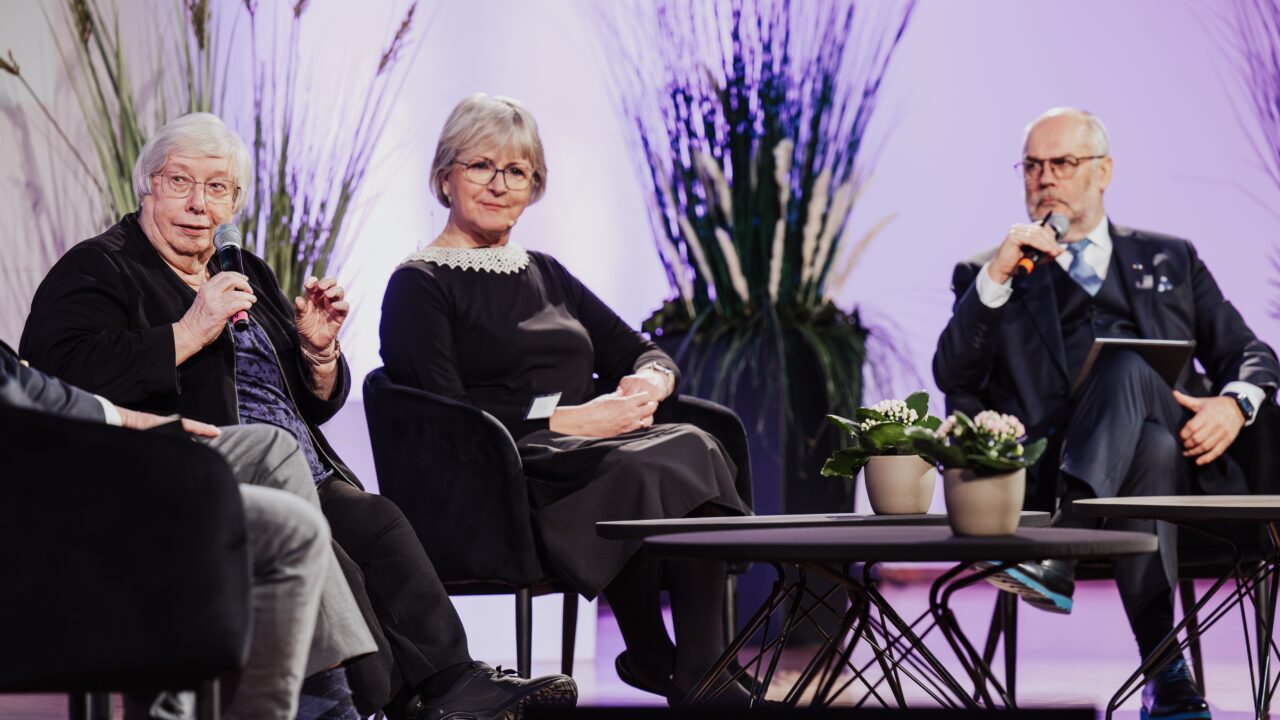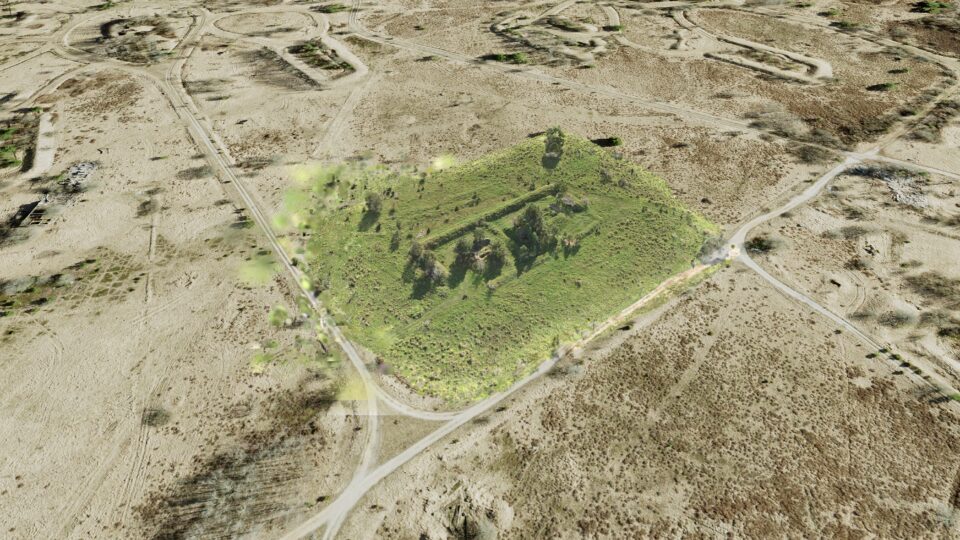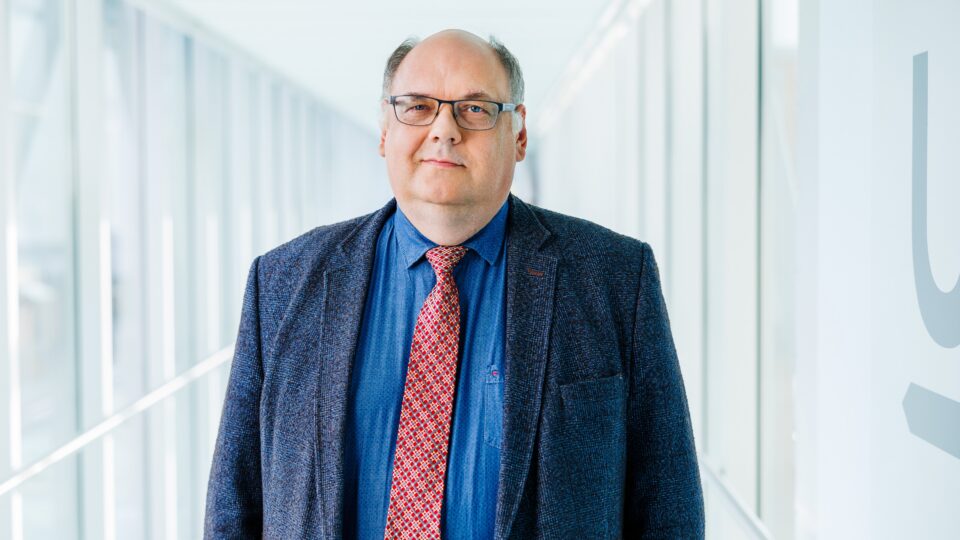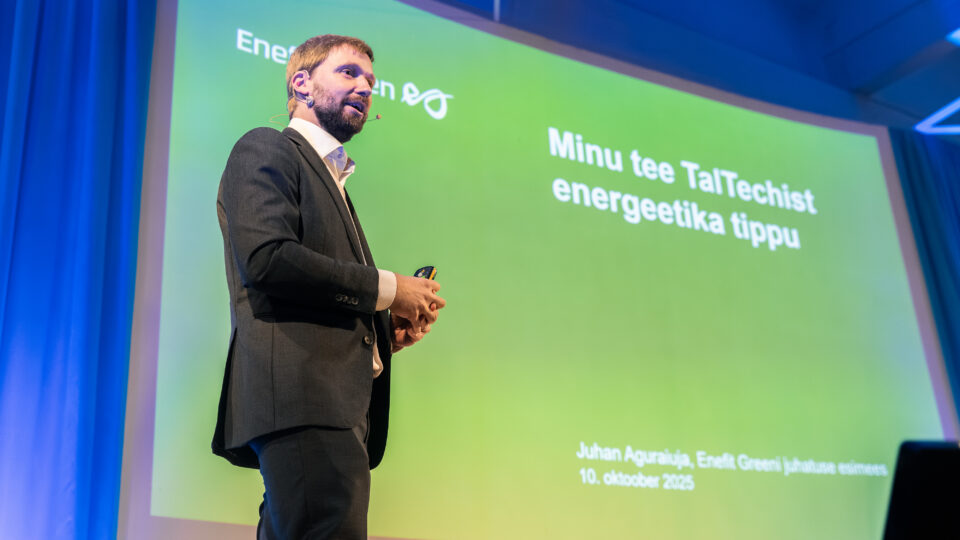On 4 February, the Estonian Rectors’ Council roundtable took place in the TalTech assembly hall, where key issues of Estonia’s higher education policy were discussed. One of the most intriguing moments of the extensive discussion was a panel moderated by the Estonian president, Alar Karis, which brought together academician and the president of the Estonian Academy of Sciences, Mart Saarma, renowned neuroscientist Jaan Aru, emeritus professor and esteemed sociologist Marju Lauristin, and board member of the Estonian Qualifications Authority, Tiia Randma. Together, they explored the future of scientific thinking and higher education.
The discussion delved into many pressing and fascinating topics, from artificial intelligence to vocational education, technological advancements, and the regression of critical thinking. Below is a partial overview of the rich exchange of ideas.
At the beginning of the discussion, Alar Karis sought answers to some fundamental questions – primarily, why we need universities and higher education and what a university’s societal role is. If this purpose were clearly defined, allocating the necessary resources to higher education would be easier.
Universities do not compete only with one another but also with the rest of the world. Companies like Microsoft and Amazon offer young people quickly attainable skills and enticing economic opportunities. Another critical issue is students’ financial resources – how rising living costs affect their economic capabilities, to what extent financial constraints force them to work alongside their studies, and how this impacts their mobility.
In light of Estonia’s Year of the Book, marking the 500th anniversary of the first known Estonian-language publication, President Karis also raised the Estonian-language education and internationalization issue. On the one hand, the Estonian language and culture must be preserved, while on the other, it is essential to think globally and engage with the broader world. This led him to ask Marju Lauristin about the reading proficiency of today’s youth.
The decline of scientific thinking ability
According to Lauristin, reading has acquired the reputation of being a challenging activity. Social norms have changed, and with them, attitudes toward intellectual work. It is significant that Lauristin specifically used the expression “hard work” in the context of thinking and reading. Mental work is not easy, and since universities teach how to engage in intellectual labour, they should not be considered places of ease either.
This claim immediately brought artificial intelligence into the discussion. In Lauristin’s view, AI makes intellectual work even more complex because, on the surface, it simplifies various cognitive challenges and problems. However, for Lauristin, the essence of intellectual work lies in deep reading, the journey from the known to the unknown, reaching new knowledge, and mental effort. To be able to do this – to learn to exert intellectual effort – one must train oneself.
Lauristin argued that our secondary and higher education systems do not sufficiently train students to seek and apply new knowledge. She recalled that during Estonia’s re-independence period (in the early 1990s), universities were emphasized as platforms for science-based education. However, society’s capacity for scientific thinking has begun to decline.
This is why Lauristin believes it is crucial to emphasize that universities do not merely provide a profession but also the ability to engage with and actively relate to knowledge – an ability that includes a broader capacity to understand both the world and oneself.
Jaan Aru added that Lauristin’s point should be conveyed directly to students: universities aim to teach them to think better and use their intellectual potential more effectively. Today, countless ideas and programs compete for young people’s attention, with universities among them. The operational capabilities of AI might even make some young people question the value of higher education, leading to the mistaken belief that AI can provide all knowledge effortlessly. However, the issue is not just about AI’s capabilities but about using technological advancements effectively and learning to interact with AI.
According to Mart Saarma, those who claim that AI will soon surpass human intelligence – or have already done so – do not fully understand the reality of the situation. The human brain has 170 billion neurons, and its internal structuring is more plastic than AI’s. As a neuroscientist, Saarma emphasized that we still do not fully understand the principles of brain function. However, what is clear is that what distinguishes a good master’s or doctoral student from AI is the ability to generate new ideas.
“Universities do not merely provide a profession but also the ability to engage with and actively relate to knowledge—an ability that includes a broader capacity to understand both the world and oneself.”
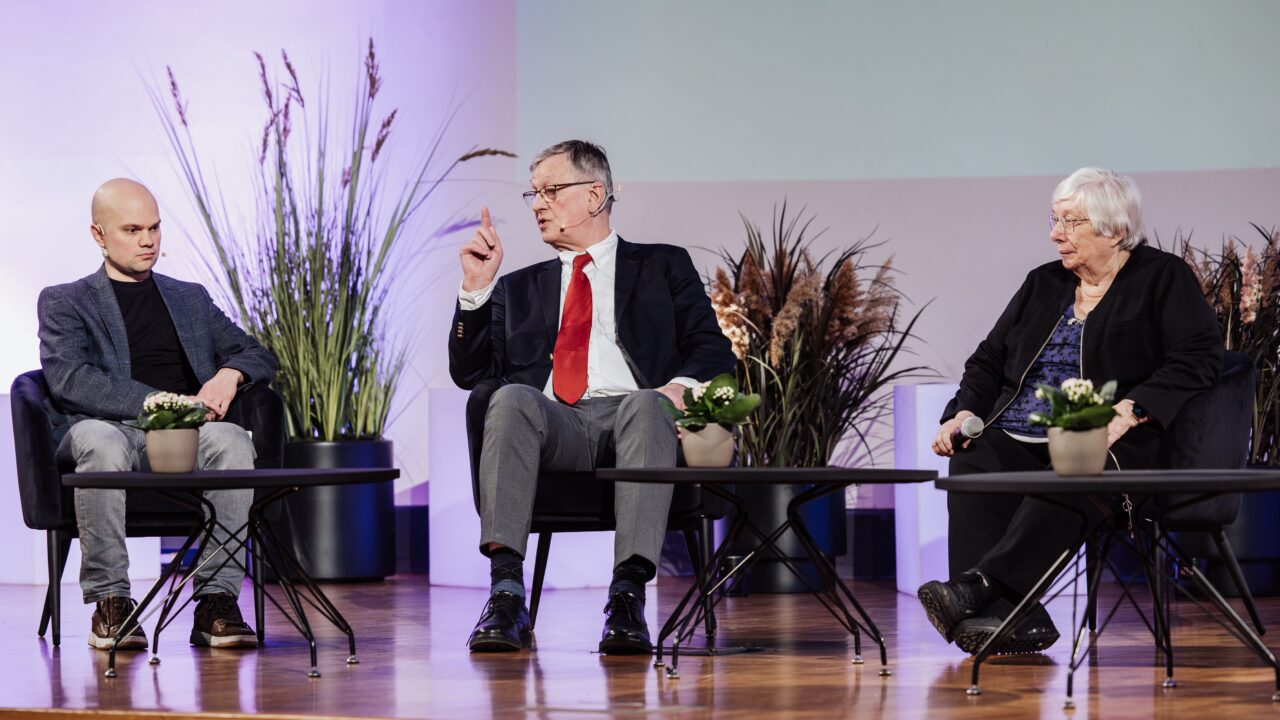
According to Mart Saarma (center), those who claim that artificial intelligence will soon surpass human capabilities—or has already done so—do not fully understand the actual state of affairs. The human brain contains 1011 neurons, and its internal structuring is incomparably more plastic than that of artificial intelligence. Photo: Rait Tuulas
The “Lion’s Leap”
According to Mart Saarma, higher education currently lacks a clear direction: do we have a generally accepted answer to where we want our society to be in ten years? In Saarma’s view, Estonia now needs a transformation of similar magnitude to the “Tiger Leap” initiative – the national program launched in 1996 to modernize the country’s education system through digitalization and internet access – something he calls the “Lion’s Leap”. He believes artificial intelligence could be the driving force behind this change. AI is already surpassing human capabilities in specific tasks, such as translation and automation, and is reshaping various fields in ways many find difficult to imagine.
Marju Lauristin referenced communication science, which has studied major societal shifts – such as the transition from oral to written communication, the revolution of the printing press, and the rise of visual media – all of which have significantly influenced human behaviour and value systems. The impact of AI has been compared to the transformation brought about by the printing press. Current information dissemination shifts have expanded the available knowledge space while reducing the time required to access it. AI has the potential to broaden human thinking.
However, for Lauristin, the central question remains: how do we prevent AI from limiting thinking while simultaneously expanding it? She believes Estonia’s small size could be an advantage in this regard, as smaller societies tend to have a stronger sense of cohesion. This allows Estonia to closely observe and study societal experiences and knowledge that profoundly impact collective consciousness, as well as the broader transformations in our perception of time and space.
Tiia Randma emphasized that, beyond technological advancements, society must also address other major influencing factors – particularly demographic challenges and value shifts. She compared society to a three-legged stool, where the legs represent technology, the environment, and professional skills. However, the seat of the stool is formed by the ability to think critically, to navigate an increasingly complex world, to adapt to rapid and intense changes, and to cope with an unpredictable social landscape.
“Estonia’s small size could be an advantage in this regard, as smaller societies tend to have a stronger sense of cohesion. This allows Estonia to closely observe and study societal experiences and knowledge that profoundly impact collective consciousness, as well as the broader transformations in our perception of time and space.”
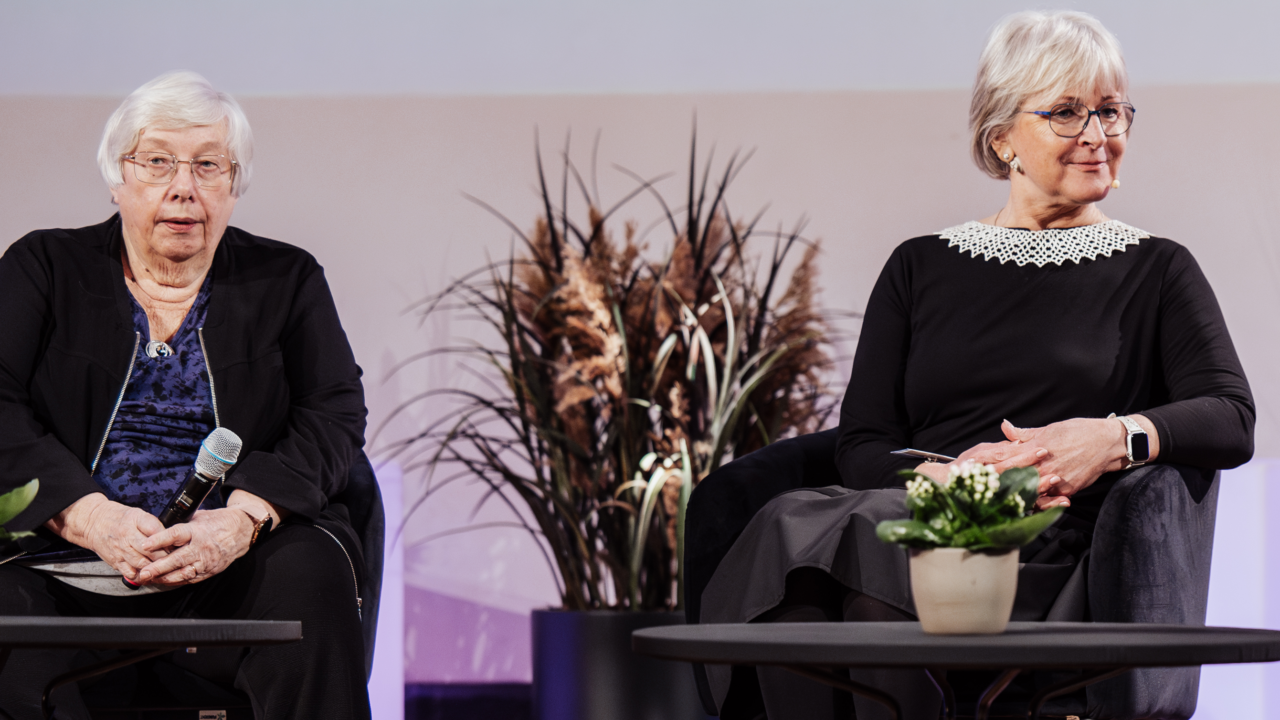
According to Tiia Randma (right), society must confront other major influencing factors alongside technological development, particularly demographic changes and shifts in values. Photo: Rait Tuulas
The role of universities is to create new ideas
Marju Lauristin agreed that demographics are indeed a crucial issue for Estonian society. This also affects higher education, as the number of PhD holders in Estonia is counted in the hundreds. With a declining population, the number of highly educated individuals will also naturally decrease. Lauristin urged the audience to recognize that maintaining a sufficient proportion of highly educated individuals is essential.
In Estonia, some fields of expertise have only a single specialist. The country loses top-level knowledge if that person enters politics or moves abroad. The reserve of such experts is very small, which increases society’s overall vulnerability. This is why Lauristin emphasized that higher education is not just an individual matter – it plays a crucial role in society’s overall resilience and functionality.
Mart Saarma elaborated on why higher education is necessary, explaining that most breakthrough technologies originate from fundamental research – fields where no one initially expected a transformative impact on society. A prime example is genetic engineering, which has grown into an industry generating $14.5 trillion in annual revenue.
Saarma argued that quality should be prioritized and that industry should play a leading role in shaping scientific directions, as seen in Finland. Science should serve both society and the economy. The primary task of universities is to generate new ideas and concepts rather than engage in routine industrial contracts. The expectation from higher education is to provide groundbreaking innovations applicable to industry.
Lauristin responded to Saarma’s argument by stating that a society’s quality is reflected in its ability to be pragmatic and to calmly and thoughtfully evaluate matters rather than get caught up in pointless conflicts. This tendency has become increasingly common. She suggested that universities have the potential to improve society as a whole.
Higher education also influences public health, as studies show that people with higher education levels are healthier. This means that higher education should not be evaluated solely in terms of economic needs or workforce demands but rather in terms of society’s broader needs.
“Society’s quality is reflected in its ability to be pragmatic and to calmly and thoughtfully evaluate matters rather than get caught up in pointless conflicts.”
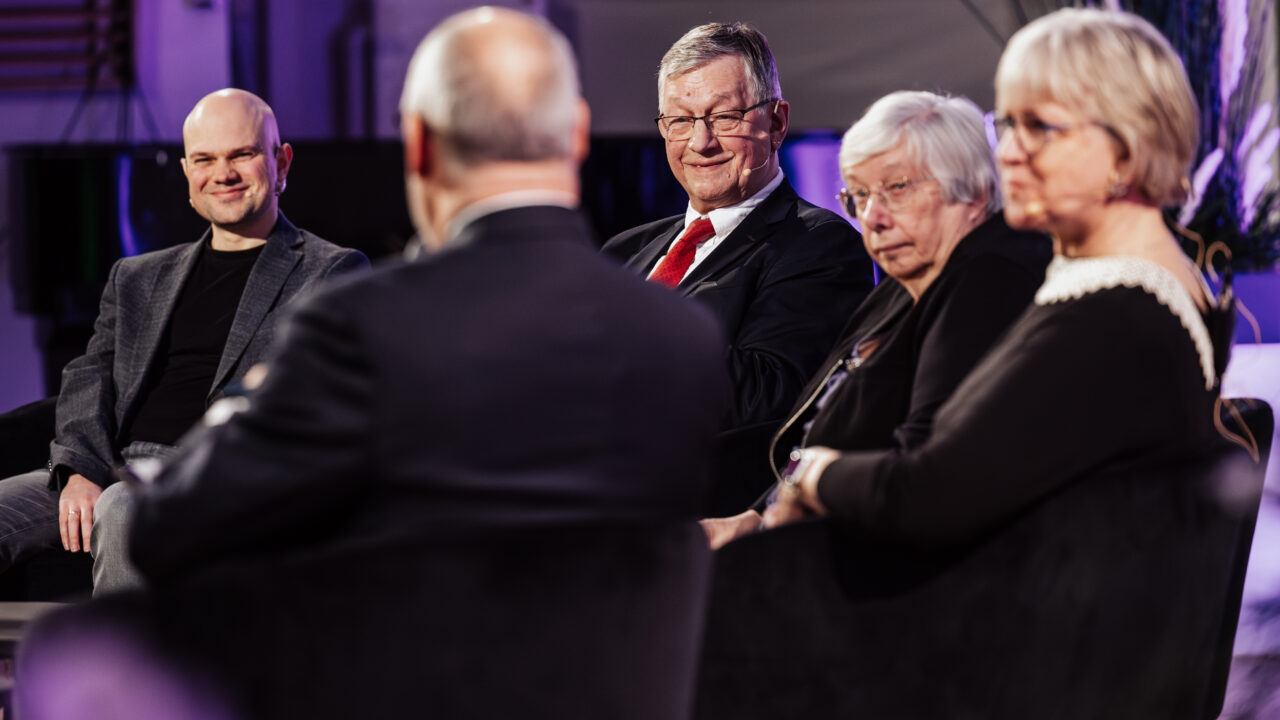
Against the backdrop of Estonia’s Year of the Book, Mr. Karis also raised a question about Estonian-language education and internationalization: on one hand, it is essential to preserve the Estonian language and culture, while on the other, it is important to think globally and engage with the world. This, in turn, prompted Mr. Karis to ask Marju Lauristin about the reading proficiency of today’s youth. Photo: Rait Tuulas
Vocational colleges could replace vocational schools
Tiia Randma emphasized the role of vocational education alongside higher education. Society needs skilled professionals in various tradespeople who can repair cars, prepare quality food, and cut hair. These professions do not necessarily require a university degree but a well-structured vocational education system. However, the current state of vocational training in Estonia is not ideal. Ideally, about one-third of the population should have vocational training, but the figure is closer to one-fourth.
Mart Saarma agreed, adding that society also needs people with strong practical skills. He noted that he has encountered students with great ideas but poor hands-on abilities – for instance, struggling to handle a pipette properly. This highlights the importance of intellect and manual skills: mente et manu – with mind and hand.
Marju Lauristin linked the discussion on vocational education to general education, praising the shift towards allowing children to shape their learning experiences based on their interests from an early age. Additionally, she suggested that vocational colleges should gradually replace vocational schools. As fields of expertise evolve, even traditionally hands-on professions, such as hairdressing, increasingly require strong educational backgrounds – for example, a solid understanding of chemistry.
The discussion about general education led President Alar Karis to raise concerns about the teacher shortage. Many young people study to become teachers, but after graduating, they often choose not to work in general education schools, instead opting for better-paying jobs in the private sector.
Mart Saarma emphasized that universities have a role in serving society in addition to research and development. However, he admitted that the exact definition of this role remains somewhat vague, and he personally prioritizes the practical application of scientific discoveries. Lauristin, in turn, argued that higher education should genuinely begin at the master’s level, where students acquire scientific thinking frameworks and develop their ability to synthesize knowledge. She pointed out that Estonia currently has science advisors with only a bachelor’s degree, which, in her view, indicates that higher education should not be shaped solely based on employer demands.
Saarma also made a blunt assessment: Estonia lacks enough high-tech industry. He stated that if he were to earn a PhD today, there would be no suitable company in Estonia where he could work at his level while remaining in the country. President Karis responded that foreign companies often hesitate to establish themselves in Estonia due to a shortage of qualified specialists in specific fields.
“Vocational colleges should gradually replace vocational schools. As fields of expertise evolve, even traditionally hands-on professions, such as hairdressing, increasingly require strong educational backgrounds—for example, a solid understanding of chemistry.”

As the discussion drew to a close, Marju Lauristin arrived at a fundamental conclusion: humans are beings capable of connecting what has already been articulated with what has yet to be expressed. This ability for self-expression—moving from the formulated to the unformulated and back—is essential for life. Photo: Rait Tuulas
Moving from the formulated to the unformulated and back
Marju Lauristin highlighted the micro-degree system’s effectiveness in enabling individuals to acquire additional skills while fostering interdisciplinary and horizontal thinking. This environment encourages the generation of new ideas. It is highly beneficial that humanities scholars can pursue micro-degrees in engineering, and engineers can do the same in the humanities. Jaan Aru expanded on this argument, adding that a university is a place where people can learn the skill of innovation. The key question, however, is how one acquires this skill.
As the discussion drew to a close, Marju Lauristin arrived at a profound conclusion: humans can connect what has already been articulated with what has yet to be expressed. This ability to move between the formulated and the unformulated – to speak the unspoken and reinterpret the known – is essential for life. This makes it all the more concerning that this capacity for association seems to be slipping away from us. Lauristin suggested that we shift our focus away from interactions with intelligent machines and return to human-to-human communication.
This statement gave the Estonian president the perfect opportunity to conclude the discussion by emphasizing the importance of reading literature. This idea is hard to dispute!
“Humans can connect what has already been articulated with what has yet to be expressed.”

